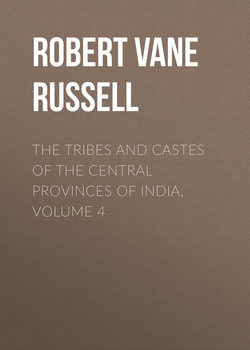Читать книгу The Tribes and Castes of the Central Provinces of India, Volume 4 - Robert Vane Russell - Страница 109
Part II
Articles on Castes and Tribes
Kumhār—Yemkala
Vol. IV
Mahār
1. General Notice
ОглавлениеMahār, Mehra, Dhed.—The impure caste of menials, labourers and village watchmen of the Marātha country, corresponding to the Chamārs and Koris of northern India. They numbered nearly 1,200,000 persons in the combined Province in 1911, and are most numerous in the Nāgpur, Bhandāra, Chānda and Wardha Districts of the Central Provinces, while considerable colonies are also found in Bālāghāt, Chhindwāra and Betūl. Their distribution thus follows largely that of the Marāthi language and the castes speaking it. Berār contained 400,000, distributed over the four Districts. In the whole Province this caste is third in point of numerical strength. In India the Mahārs number about three million persons, of whom a half belong to Bombay. I am not aware of any accepted derivation for the word Mahār, but the balance of opinion seems to be that the native name of Bombay, Mahārāshtra, is derived from that of the caste, as suggested by Wilson. Another derivation which holds it to be a corruption of Maha Rāstrakūta, and to be so called after the Rāshtrakūta Rājpūt dynasty of the eighth and ninth centuries, seems less probable because countries are very seldom named after ruling dynasties.110 Whereas in support of Mahārāshtra as ‘The country of the Mahārs,’ we have Gujarāshtra or Gujarāt, ‘the country of the Gūjars,’ and Saurāshtra or Surat, ‘the country of the Sauras.’ According to Platts’ Dictionary, however, Mahārāshtra means ‘the great country,’ and this is what the Marātha Brāhmans themselves say. Mehra appears to be a variant of the name current in the Hindustāni Districts, while Dheda, or Dhada, is said to be a corruption of Dharadas or billmen.111 In the Punjab it is said to be a general term of contempt meaning ‘Any low fellow.’112
Wilson considers the Mahārs to be an aboriginal or pre-Aryan tribe, and all that is known of the caste seems to point to the correctness of this hypothesis. In the Bombay Gazetteer the writer of the interesting Gujarāt volume suggests that the Mahārs are fallen Rājpūts; but there seems little to support this opinion except their appearance and countenance, which is of the Hindu rather than the Dravidian type. In Gujarāt they have also some Rājpūt surnames, as Chauhān, Panwār, Rāthor, Solanki and so on, but these may have been adopted by imitation or may indicate a mixture of Rājpūt blood. Again, the Mahārs of Gujarāt are the farmservants and serfs of the Kunbis. “Each family is closely connected with the house of some landholder or pattidār (sharer). For his master he brings in loads from the fields and cleans out the stable, receiving in return daily allowances of buttermilk and the carcases of any cattle that die. This connection seems to show traces of a form of slavery. Rich pattidārs have always a certain number of Dheda families whom they speak of as ours (hamāra) and when a man dies he distributes along with his lands a certain number of Dheda families to each of his sons. An old tradition among Dhedas points to some relation between the Kunbis and Dhedas. Two brothers, Leva and Deva, were the ancestors, the former of the Kunbis, the latter of the Dhedas.” 113 Such a relation as this in Hindu society would imply that many Mahār women held the position of concubines to their Kunbi masters, and would therefore account for the resemblance of the Mahār to Hindus rather than the forest tribes. But if this is to be regarded as evidence of Rājpūt descent, a similar claim would have to be allowed to many of the Chamārs and sweepers. Others of the lowest castes also have Rājpūt sept names, as the Pārdhis and Bhīls; but the fact can at most be taken, I venture to think, to indicate a connection of the ‘Droit de Seigneur’ type. On the other hand, the Mahārs occupy the debased and impure position which was the lot of those non-Aryan tribes who became subject to the Hindus and lived in their villages; they eat the flesh of dead cattle and this and other customs appear to point decisively to a non-Aryan origin.
110
This derivation is also negatived by the fact that the name Mahāratta was known in the third century B.C., or long before the Rāstrakūtas became prominent.
111
Bombay Gazetteer; Gujarāt Hindus, p. 338.
112
Ibbetson, Punjab Census Report (1881).
113
Bombay Gazetteer, l.c. text and footnote by R. v. J. S. Taylor.
